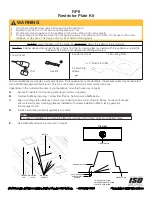
23
ENGLISH
Maintenance
Cleaning the glass
Jøtul F
220
is equipped with top draught (air wash). With
the aid of the draught vent, air is sucked in from above the
fireplace and washed down along the inside of the glass.
This system has the advantage that it results in better
combustion and reduced soot deposits on the glass.
Still, some soot will always stick to the glass, but the
quantity will depend on the local draught conditions and
adjustment of the draught vent. Most of the soot layer will
normally be burned off when the draught vent is opened
all the way and a fire is burning briskly in the fireplace.
Some good advice: For general cleaning, soak some
kitchen roll in hot water and dip it into some ash from the
combustion chamber. Rub the glass with the kitchen roll.
Wipe off the glass with clean water and dry completely.
Removal of ash (fig. 5)
The Jøtul F
220
has an ash pan inside to facilitate the
removal of ash. Push the ash through the grate in the base
plate and down into the ash pan.
See also the description of how to handle ash under:
Measure for fire prevention.
Cleaning and soot removal
When the stove is being used, soot may be deposited on
the inside of the stove’s hot surfaces. Soot has a good
insulation effect and will therefore reduce the amount
of heat given off by the stove. Cleaning the inside once
a year will be necessary in order to obtain the maximum
amount of heat from the product. It is suggested that this
is carried out at the same time as cleaning the chimney
and flue pipe.
Sweeping the flue pipe to the
chimney
The simplest way to clean the flue pipe is to remove the
baffle plate and sweep through the door of the stove. If
the flue outlet is on top of the stove the pipe may be swept
through the sweeping hatch in the pipe.
Checking the stove
Jøtul recommends that the stove is checked thoroughly
after sweeping/cleaning. Check all visible surfaces for
fissures. Ensure that all joints are tight and that gaskets are
correctly positioned in the door. Gaskets that are worn out
or deformed should be replaced. Clean the gasket groove
thoroughly, add ceramic adhesive (may be purchased from
your local Jøtul dealer), and press the gasket well into place.
The joint will dry after a short period.
External maintenance
Painted products
may, after some years of use, discolour.
The surface should be wiped and brushed free of loose
particles before new paint is applied.
Enamelled products
need only to be wiped with a dry cloth.
Do not use soap and water. Spots can be removed with a
cleaning liquid (a cooker oven cleaner or similar).
Wood length, quantity and quality
The wood logs should be a maximum length of 34 cm.
Jøtul F
220
has with its efficiency a nominal capacity of 6,0
kwh. According to calculations, the nominal heat output
will consume 2,4 kg quality wood per hour.
Jøtul’s definition of quality wood
Good quality wood should be dried so that the water
content is approximately 20%. To achieve this, the wood
should be cut during late winter, or early in the spring
and stacked in such a way as to air out. The stacks must
be covered over to keep rainwater off. The wood should be
taken in during early autumn and stacked/stored for use
during the coming winter. By quality wood, it is defined
as well-known types of wood such as beech, spruce and
pine.
The energy mass of 1 kg wood varies little. On the other
hand, the net weight of the different kinds of wood varies
considerably. This means that the net weight of a specific
amount of birch will give a lower kwh than the same
amount of oak. The energy mass of 1 kg quality wood is
around 3.8 kwh. 1 kg completely dry wood (0 % moisture)
content approx. 5 kwh, whilst wood with a moisture level
of 60 % content only approx. 1.5 kwh/kg.
Содержание F 220
Страница 2: ...2...
Страница 55: ...55...
Страница 56: ...56 Fig 2 Fig 3 Fig 3 B Fig 4 Fig 5 Fig 6 Fig 7 D C A B Fig 8 A According to DIN Fig 2 A...
Страница 57: ...57...
Страница 58: ...58...
















































